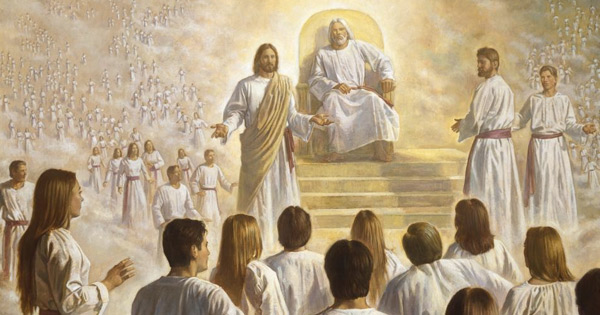Question
Dear Gramps,
Should the quotation from John Taylor be interpreted as meaning that those who do not marry in this life may have the opportunity to do so in the millennium, thereby attaining exaltation, if they are otherwise worthy? I have been an “investigator” of the Mormon church for about a year, and Doctrine & Covenants 131 has been a major obstacle to a decision to seek to join. I recall reading in the King Follet Sermon that Joseph Smith said children also sit upon thrones, but the King Follet Sermon is not scripture. However, is there not a contradiction between D&C 131 and the King Follet Sermon, spoken by Joseph Smith himself. And while not scripture, is not the King Follet Sermon a coherent summary of Mormon thought?
I am not married, and I have to question if God would hold it against a man who was single, and for whom the opportunity for marriage did not, or has not yet, presented itself.)
On another subject, what is the scriptural basis for the doctrine of continuing revelation? I tend to adhere to the doctrine of solo scriptura, that scripture is the final authority, not the pronouncements of men. (However, I did once read that a question was put to Brigham Young–I cannot recall what the question was–and Brigham Young replied to the effect, “Why should I ask dead prophets when I can ask a living one?” My quote is from memory and not exact.)
(What has attracted me to the Mormon Church is its doctrine on the Trinity: that the Father, Son, and Holy Spirit are separate beings, united in purpose, which is contrary to the teachings of other churches; and the generally more conservative social stance of the Church, among other things. However, I have difficulty accepting, or understanding, D$C 131).
Shane
Answer
Dear Shane,
First, let’s talk about the doctrine of solo scriptura., and the question to ask is, where did the scriptures come from and how were they canonized? Moses wrote the record that we now have as the first five books of the Bible. Since it contained the Law of Moses, or the Ten Commandments, it became known as the Law– the Torah in Jewish literature. The rest of the Bible consists of the Prophets–comprising the books of Joshua, Judges, Ruth, 1&2 Samuel, 1&2 Kings, Isaiah, Jeremiah, Ezekiel, Hosea, Joel, Amos, Obadiah, Micah, Nahum, Habakkuk, Zephaniah, Haggai, Zechariah and Malachi; and what have come to be called he Writings–consisting of 1&2 Chronicles, Ezra and Nehemiah, Esther, Job, Psalms, Proverbs, Ecclesiastes, Song of Solomon, and Daniel.
All these books were compiled as sacred records sometime after they were written, so they were all additions to the original Torah. I don’t know if there is a record of when each new writing was “canonized,” or by whom. The Savior referred to the Law and the Prophets in the New Testament—
The law and the prophets were until John: since that time the kingdom of God is preached, and every man presseth into it (Luke 16:16).
Some of that preaching was written, collected and added to what has come to be known as the Bible. When you talk of solo scriptura, you imply some arbitrary cut-off date for the collection of scripture, and recognize some authority for doing so. That sacred writings were to continue as long as the earth were to stand is definitively declared in the “canonized” scripture.
Surely the Lord GOD will do nothing, but he revealeth his secret unto his servants the prophets (Amos 3:7).
So, after the great apostasy, when God’s kingdom was again restored, prophets were again called to receive God’s word and reveal it to the people. The words of God’s prophets speaking today are equally as valid as those spoken by God’s prophets anciently, and are infinitely more pertinent to the particular conditions of today than were those of former times.
And now to your initial question of the necessity of being married in order to receive exaltation in the celestial kingdom. A full treatment of this topic is of such a sacred nature that it would not do to have it displayed before the world in a public column, but let’s approach it as we may. As mentioned in Section 131 of the Doctrine and Covenants,
In the celestial glory there are three heavens or degrees;
And in order to obtain the highest, a man must enter into this order of the priesthood [meaning the new and everlasting covenant of marriage];
And if he does not, he cannot obtain it.
He may enter into the other, but that is the end of his kingdom; he cannot have an increase (D&C 131:1-4).
The key phrase in this scripture is he cannot have an increase. You see, God is the Father of the spirits of all mankind—
Furthermore we have had fathers of our flesh which corrected us, and we gave them reverence: shall we not much rather be in subjection unto the Father of spirits, and live? (Heb 12:9)
Thus, Mankind, as children of God, have the same inherent possibility as does every other living creature, of maturing to an eternal adulthood–to become like its Father. Paul said—
The Spirit itself beareth witness with our spirit, that we are the children of God: And if children, then heirs; heirs of God, and joint-heirs with Christ; if so be that we suffer with him, that we may be also glorified together (Rom 8:16-17).
If we live to inherit what God has, and to be glorified together with Him, and to have an increase, we must of necessity have a wife. The fact is that exalted beings, have the possibility of procreation, and the children born to them will be of spiritual material, just we were spirits when born of our Father in Heaven.
Now, one of the great purposes of the Millennial reign of Christ on the earth will be to provide opportunity for all those did not have the opportunity during mortality to receive all the ordinances of the gospel to be able to receive them during the millennium.
“God has commanded [his servants] to perform ordinances in his temple which are essential to redeem the dead and save the living. The Latter-day Saints continue actively engaged in that glorious and sacred work. Already (1928) there have been performed, in the Latter-day Saint temples, more than twelve million ordinances in behalf of the dead, (more than 23 million in 1935) in addition to about six hundred thousand for the living. This is only a beginning; it will be continued, in hundreds of temples, during the Millennium now dawning, until God’s almighty purposes concerning the salvation and redemption of all his children are fully accomplished” (Handbook of the Restoration: A Selection of Gospel Themes Discussed by Various Authors , p.501).
The doors of the holy temple are the doors to exaltation in the celestial kingdom of God. Only those who live by the covenants they make in the temple, which include the sacred covenant of eternal marriage may receive the glory of exaltation.
Gramps







